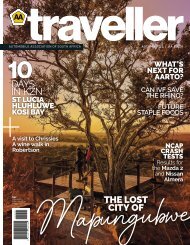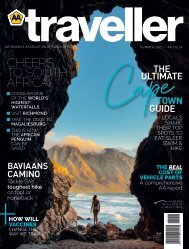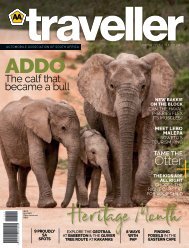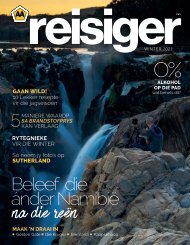Traveller SPRING 2022
The magazine of the Automobile Association of South Africa
The magazine of the Automobile Association of South Africa
Create successful ePaper yourself
Turn your PDF publications into a flip-book with our unique Google optimized e-Paper software.
Science<br />
In 2017, some of this work led to her<br />
doctorate from Rhodes University about<br />
a genus of South African snails called<br />
Chondrocyclus. These live in forests and<br />
thicket. She described twelve new species<br />
that no one had noticed before in the<br />
process. There’s good reason for that: the<br />
biggest Chondrocyclus species is the size<br />
of a Panado, but most are smaller. And their<br />
dark brown shells are often caked with soil,<br />
making them doubly difficult to spot.<br />
The equally tiny Gulellas are slightly<br />
easier to find, because their white shells<br />
tend to stand out against dark soil. Over the<br />
years, Mary has described 16 such species<br />
– the most recent being eight in a paper<br />
published earlier this year with Dai.<br />
Among those she named is<br />
Chondrocyclus kevincolei. It was named as<br />
such in a 2019 paper in the scientific journal<br />
European Journal of Taxonomy, and it’s<br />
Mary’s way of thanking her husband, Kevin,<br />
for his indispensable assistance on fieldtrips.<br />
Mary recently completed an index of all<br />
558 species and 12 subspecies of land snail<br />
found in South Africa. Her efforts were part<br />
of the South African National Biodiversity<br />
Institute’s (SANBI) collation of a thorough<br />
checklist of the country’s animals, including<br />
vertebrates and invertebrates.<br />
Members of the Sheldonia<br />
genus of land snails are<br />
commonly called tailwagger<br />
snails.<br />
How to find a snail<br />
Mary fully realises that there are generally<br />
three camps when it comes to snails: you<br />
either love them, you hate them, or you<br />
know almost nothing about them. Mary, of<br />
course, falls into the first camp.<br />
She is therefore quick to point out that<br />
among the world’s 30 000 land snail<br />
species, only about a hundred are of the<br />
common garden variety that have become<br />
agricultural pests.<br />
“Very few have any sort of interaction<br />
with people. Most are very small and live<br />
their whole lives in forests or concealed<br />
among leaf litter, without us even knowing<br />
they’re there.”<br />
To go snail hunting, you need a careful<br />
eye, a torch, even some magnifying lenses,<br />
a fair share of luck, and a willingness to<br />
get muddy hands and knees. Forests,<br />
especially those along South Africa’s<br />
eastern coastline, tend to be the obvious<br />
spots to look for land snails. Some hide<br />
among decomposing leaves or under logs<br />
or rocks, while others are easier to find as<br />
they scrape algae off tree trunks.<br />
“Remember to look up when you are in a<br />
forest. Some species live in trees. You may<br />
see their silhouettes as they sit on leaves.”<br />
“Snails are generally only active after rain,<br />
in damp conditions,” she notes.<br />
“Most local species are found in the<br />
eastern half of the country, the wetter areas.<br />
For snails it’s a big challenge to live on<br />
land, so it’s actually amazing that so many<br />
species have adapted to do so.”<br />
It might therefore come as a surprise that<br />
some species live in the aloes in the Karoo<br />
or that a whole family of land snails, the<br />
Dorcasiidae, is endemic to the dry western<br />
parts of southern Africa.<br />
“The Dorcasiidae contain 13 species in<br />
South Africa, and are found in the Western<br />
Cape, Northern Cape and Eastern Cape and<br />
extend into Namibia and Botswana.” Among<br />
them are some of the earliest South African<br />
land snails ever described, including<br />
Trigonephrus rosaceus, which was already<br />
identified in 1774 by Danish naturalist Otto<br />
Friedrich Müller, and Trigonephrus<br />
namaquensis from Namaqualand, named<br />
as such in 1891.<br />
Images: Mary Cole, Kevin Cole and Dai Herbert<br />
46<br />
Marjorie’s snail<br />
The first example of Gulella latimerae was collected in 2000,<br />
in the Kumqolo Forest near Xhora. According to a paper Mary<br />
and Dai wrote in African Invertebrates in 2004 about it and three<br />
of their other snail discoveries, it is only known to occur in four<br />
forest patches along the Eastern Cape Wild Coast, between<br />
Mazeppa Bay and Ntafufu.<br />
“Many of the species we have discovered are only found in very<br />
small areas. It reflects the very patchy nature of forests, and how<br />
species have evolved over millennia in isolation because they<br />
cannot easily disperse to new areas,” explains Mary.<br />
“From a conservation point of view, it is therefore always<br />
important to conserve our indigenous forests and the habitats<br />
of our indigenous species, because most are only found in<br />
small areas.”<br />
AA <strong>Traveller</strong> | <strong>SPRING</strong> <strong>2022</strong>

















